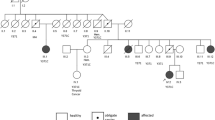Abstract
We describe the previously unreported condition of Hodgkin’s lymphoma in a patient with Noonan syndrome caused by germ-line mutations (1507G > C, Gly503Arg) in exon 13 of the PTPN11 gene. PTPN11, encoding SHP-2, is the first identified gene for Noonan syndrome and also the first identified proto-oncogene that encodes a tyrosine phosphatase. This somatic mutation has ever been reported in juvenile myelomonocytic leukemia (JMML). Furthermore, the functional analysis of this mutant SHP-2 has shown it to have enhanced phosphatase activity. Mutational analysis of PTPN11 gene in cancer cells and understanding how SHP-2 contributes to oncogenesis will provide new insight into the pathogenesis of Hodgkin’s lymphoma.


Similar content being viewed by others
References
Harris NL, Jaffe ES, Stein H, et al. A revised European-American classification of lymphoid neoplasms: a proposal from the international lymphoma study group. Blood. 1994;84:1361–92.
Kapatai G, Murray P. Contribution of the Epstein-Barr virus to the molecular pathogenesis of Hodgkin lymphoma. J Clin Pathol. 2007;60:1342–9.
Landgren O, Caporaso NE. New aspects in descriptive, etiologic, and molecular epidemiology of Hodgkin’s lymphoma. Hematol Oncol Clin North Am. 2007;21:825–40.
Tartaglia M, Mehler EL, Goldberg R, et al. Mutations in PTPN11, encoding the protein tyrosine phosphatase SHP-2, cause Noonan syndrome. Nat Genet. 2001;29:465–8.
Zenker M, Buheitel G, Rauch R, et al. Genotype–phenotype correlations in Noonan syndrome. J Pediatr. 2004;144:368–74.
Chan RJ, Feng GS. PTPN11 is the first identified proto-oncogene that encodes a tyrosine phosphatase. Blood. 2007;109:862–7.
Mohi MG, Neel BG. The role of SHP2 (PTPN11) in cancer. Curr Opin Genet Dev. 2007;17:23–30.
Tartaglia M, Niemeyer CM, Fragale A, et al. Somatic mutations in PTPN11 in juvenile myelomonocytic leukemia, myelodysplastic syndromes and acute myeloid leukemia. Nat Genet. 2003;34:148–50.
Bentires-Alj M, Paez JG, David FS, et al. Activating mutations of the Noonan syndrome associated SHP2/PTPN11 gene in human solid tumors and adult acute myelogenous leukemia. Cancer Res. 2004;64:8816–20.
Neel BG, Gu H, Pao L. The ‘SHP’ing news: SH2 domain-containing tyrosine phosphatase in cell signaling. Trends Biochem Sci. 2003;28:284–93.
Kosaki K, Suzuki T, Muroya K, et al. PTPN11 (protein-tyrosine phosphatase, nonreceptor-type 11) mutations in seven Japanese patients with Noonan syndrome. J Clin Endocrinol Metab. 2002;87:3529–33.
Tartaglia M, Kalidas K, Shaw A, et al. PTPN11 mutations in Noonan syndrome: molecular spectrum, genotype–phenotype correlation, and phenotypic heterogeneity. Am J Hum Genet. 2002;70:1555–63.
Noonan JA, Ehmke DA. Associated non cardiac malformations in children with congenital heart disease. J Pediatr. 1963;63:468–70.
Sharland M, Burch M, McKenna WM, Paton MA. A clinical study of Noonan syndrome. Arch Dis Child. 1992;67:178–83.
van der Burgt I, Thoonen G, Roosenboom N, et al. Patterns of cognitive functioning in school-aged children with Noonan syndrome associated with variability in phenotypic expression. J Pediatr. 1999;135:707–13.
Hung CS, Lin JL, Lee YJ, et al. Mutation analysis of PTPN11 gene in Taiwanese children with Noonan syndrome. J Formos Med Assoc. 2007;106:169–72.
Schubbert S, Zenker M, Rowe SL, et al. Germ-line KRAS mutations cause Noonan syndrome. Nat Genet. 2006;38:331–6.
Roberts AE, Araki T, Swanson KD, et al. Germ-line gain-of-function mutations in SOS1 cause Noonan syndrome. Nat Genet. 2007;39:70–4.
Tartaglia M, Pennacchio LA, Zhao CH, et al. Gain-of-function SOS1 mutations cause a distinctive form of Noonan syndrome. Nat Genet. 2007;39:75–9.
Tartaglia M, Gelb BD. Germ-line and somatic PTPN11 mutations in human disease. European J Med Genet. 2005;48:81–96.
Niihori T, Aoki Y, Ohashi H, et al. Functional analysis of PTPN11/SHP-2 mutants identified in Noonan syndrome and childhood leukemia. J Hum Genet. 2005;50:192–202.
Acknowledgments
This research was supported by Grant CMRPG460061 and CMRPG32048 awarded by the Chang Gung Memorial Hospital, Taiwan.
Conflict of interest disclosure
The authors declare no competing financial interests.
Author information
Authors and Affiliations
Corresponding author
About this article
Cite this article
Lo, FS., Kuo, TT., Wang, CJ. et al. Hodgkin’s lymphoma in a patient with Noonan syndrome with germ-line PTPN11 mutations. Int J Hematol 88, 287–290 (2008). https://doi.org/10.1007/s12185-008-0157-5
Received:
Accepted:
Published:
Issue Date:
DOI: https://doi.org/10.1007/s12185-008-0157-5




